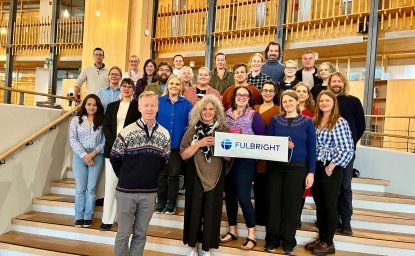A Historic Voyage
On August 25, 2021, USCGC Healy departed Seward, Alaska for its first transit through the Northwest Passage in nearly 20 years, in cooperation with Canada. A team of scientists from the U.S. carried out a diverse research program during the journey. Larry Mayer of the University of New Hampshire and Chief Scientist for the Northwest Passage expedition was responsible for organizing and communicating the varied research that took place, including his own work conducting bathymetric surveys of the Passage. Improving seafloor maps in this poorly studied area through these surveys will be critical as vessel traffic, fishing, energy development, and other activities increase in the Arctic in response to ongoing reduction of sea ice cover.
After exiting the Passage and a crew change in Nuuk, Greenland, Healy began a three-week expedition in Baffin Bay. Bob Pickart of the Woods Hole Oceanographic Institution took over as Chief Scientist overseeing another varied set of research projects with scientists from Canada and Norway joining those from the U.S. His own research in Baffin Bay focused on basal melting of coastal glaciers and ice sheets, which is the influence of warm subsurface currents on the coastal ice margin at depth. This process exacerbates melting from above due to atmospheric and ocean surface warming, compounding the downstream oceanographic effects of warming on mid-latitude waters.
Healy is the U.S. Coast Guard’s largest vessel and the most technologically sophisticated icebreaker in the U.S. fleet. Equipped with a number of sensors, flow-through systems, and other equipment, ship time is in high demand by the scientific community. Assembling research teams, like those that worked during the Northwest Passage and Baffin Bay cruises, is a process managed by Dave Forcucci with USCG Icebreaker Science Operations and guided by the Arctic Icebreaker Coordinating Committee of the University National Oceanographic Laboratory System. The scientific work of Healy continues even after the research teams disembark through a suite of oceanographic and meteorological variables measured underway. Shawn Smith at Florida State University oversees the integration of these observations from Healy and 32 other vessels participating in the Shipboard Automated Meteorological and Oceanographic System (SAMOS). SAMOS manages a data assembly center that makes data available to interested users. Observations underway began when Healy departed from its home port of Seattle, Washington, and continued after Healy left the Northwest Atlantic, passed through the Panama Canal, and steamed back up to Seattle – a historic circumnavigation of North America.
Changing Ocean Ecosystems
In an area that is as vast, remote, and sparsely populated as Nunavut and the Canadian Arctic, community science that draws upon the ecological knowledge of resident people can be a powerful complement to traditional scientific tools. Christina MacDonald with the Arctic Eider Society explained how this idea inspired SIKU, the Indigenous Knowledge Social Network, which ingests user reports on environmental conditions – including wildlife, ice cover, ship traffic, and more – and makes that information accessible through a portfolio of electronic tools and data products. Across Baffin Bay, Lorenz Meire with the Greenland Climate Research Centre also addressed the fate of changing ice cover along the Greenland coast as it influences coastal and ocean environments, specifically the dynamics of glaciers and the role of fjords as gateways of interactions between land and sea. Glacial melt enhances upwelling of nutrients to surface waters which fuels planktonic production, a function that is lost as glaciers recede. The influence of ice on the ocean continues beyond the coast, including through the fate of icebergs as they move south along the Labrador Current, as discussed by Kristin Schild at the University of Maine. The melting of icebergs during advection to warmer latitudes affects surface temperatures, salinity, circulation, and water levels, while also creating an obstacle for navigation. Further, changes in ice sheets, glaciers, and icebergs not only affect surface waters and pelagic habitat, but are also driving significant changes on the seafloor. Mark Patterson of Northeastern University, but on sabbatical at Université Laval during the program, described how warmer temperatures, deeper light penetration, and increased atmospheric interactions could be paving the way for dramatic expansion of kelp beds into high latitudes. These habitats are home to complex ecological communities and commercially important species, so this ecosystem shift could have profound implications for biodiversity and fisheries in the Arctic region.
Arctic influences on the ocean extend south to the subpolar Northwest Atlantic and interact with other changing processes in the waters south of Greenland and offshore from Newfoundland and Labrador. In particular, Jaime Palter at the University of Rhode Island explained how an extension of the Gulf Stream tail toward the Grand Banks is restricting the flow of the Labrador Current to the southwest. This restriction might also be related to climate-driven changes in the Atlantic Meridional Overturning Circulation (AMOC), although AMOC could be shifting toward interior pathways and having less influence offshore. Within these evolving current systems, a diverse and productive pelagic ecosystem is in flux. Maxime Geoffroy with Memorial University surveyed important ecological trends, including a shift toward smaller zooplankton species and northward expansion of the ranges of cod, herring, capelin, sand lance, and other fishes. However, range expansion will be hindered by persistent features of the Arctic region that are not affected by climate change. One such feature is day length, which is especially important to the life history of lanternfish, the most abundant fish in the Labrador Sea. Jamie Tam at the Bedford Institute of Oceanography noted that subpolar ocean ecosystems in the Northwest Atlantic have not only been reshaped by climate change but also by other anthropogenic impacts, especially overfishing that led to the collapse of cod in the early 1990s. To keep pace with these changes, ecosystem modeling that considers the effects of multiple environmental drivers is advancing and being incorporated into stock assessments and other tools that support natural resource management.
Expansion of the Gulf Stream not only affects the influence of the Labrador Current on mid-latitude areas, but also directly influences the Scotian Shelf and Gulf of Maine. Gordon Zhang at the Woods Hole Oceanographic Institution illustrated the increasing frequency of warm core rings that carry salty and low-nutrient water into these shelf systems, and contributes to the long-term warming trend underway. These changes are affecting the biological and ecosystem productivity of the Gulf of Maine, especially through the deprivation of nutrient-rich Arctic waters. Changes in productivity manifest in different and complex ways, including two highlighted by Michelle Staudinger with the U.S. Geological Survey: the timing of key events in the life histories of different species, known as phenology, and the overall species composition of ecosystems. Many life history events are taking place earlier in the year as waters warm, which can create phenological mismatches with key oceanographic events, and favors ecological generalists that are more adaptive to uncertainty and evolving conditions. Among the many species experiencing these transitions, considerable attention is being paid to the plight of endangered marine mammals, especially North Atlantic right whales (NARW). Jen Miksis-Olds at the University of New Hampshire highlighted the urgency of expanding coverage of acoustic monitoring systems for detection, status determination, and long-term predictions of the NARW population. Acoustic systems can also reveal broader soundscapes in the ocean, which can enhance understanding of phenology and other aspects of the ecosystem, such as auditory cues used for navigation by different species.
Generous support was provided by the U.S. Embassy & Consulates in Canada through the Arctic Region Virtual Grant Program. Sustaining support for NERACOOS is provided by the U.S. Integrated Ocean Observing System, and for CIOOS Atlantic by Canada’s Department of Fisheries & Oceans and Marine Environmental Observation Prediction & Response Network. The program was also endorsed as an official activity of the United Nations Decade of Ocean Science for Sustainable Development, which helped with promotion and participation. We are grateful to all!
Authors
- Jake Kritzer, Executive Director, Northeastern Regional Association of Coastal Ocean Observing Systems (NERACOOS)
- Shayla Fitzsimmons, Executive Director, Canadian Integrated Ocean Observing System (CIOOS) Atlantic Regional Association






